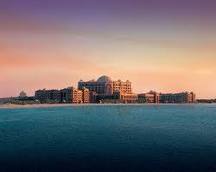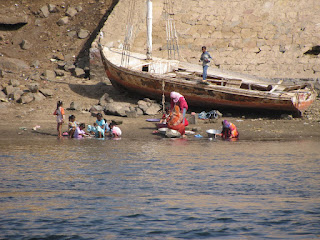The girls have a week off of school for Eid al-Adha. This year the floating holiday ended up in the middle of November. Even though Hannah and I had just come back from Thailand, we decided to make the most of our free time in the Middle East and go to Egypt, a country that all of us have been wanting to visit.
Cairo, including the surrounding area, has a population of about 20 million. At any given time, from what I can tell, 10 million are in their cars, busses, toktoks (3 wheeled open cabs), or donkey driven carts. The other 10 million are pedestrians trying to cross the street, with 8 lanes of solid traffic and no traffic lights, acting like it's a leisurely stroll in the countryside. Somehow it all works, as long as you don't mind hearing a constant symphony of car horns.
We had been warned that Cairo is very dirty, and it's true. Certain neighborhoods are kept clean, but many have piles of garbage everywhere. If there is a plot of land without a building, it is used as a junkyard. Stray dogs help to clean up. There is also garbage floating in the many canals around Cairo and egrets help to take care of the flotsam.
To add to the mix, there were live sheep and goats everywhere:
Muslim families celebrate Eid al-Adha with the slaughtering of a sheep or goat, a tradition commemorating the story of Abraham's willingness to sacrifice his own son Ismail (at the last minute, a ram is allowed to be slaughtered instead and Ismail is saved). The meat is shared with friends, family, and the poor. Since many Egyptian Muslims still prefer to slaughter their own sheep, the streets of Cairo are full of flocks of sheep and goats around Eid al-Adha, right by the 8 lanes of traffic.
Despite the craziness of Cairo, a trip to the Pyramids of nearby Giza makes it all worthwhile. They were built between 2600 and 2100 BC. Walking around these ancient and enormous structures is an amazing experience. It is awesome in the true sense of the word.
It is hard not to get a good photo of the sphinx with a pyramid.
We highly recommend a camel ride at the pyramids.
After lunch, a papyrus paper making shop, and a perfume factory, we visited the Egyptian Museum. Photos aren't allowed. It is old, badly lit, and dusty, but the exhibits are stunning and speak for themselves. The treasures from Tutankhamun's tomb are absolutely breathtaking. A new museum if under construction near the Pyramids of Giza and should be complete (in shaa'a l-laah) within the next few years. This will be a welcome new home for Egypt's amazing and expansive collection.
The next day we visited the Citadel. It is a walled compound set on top of a craggy hill, first built by Muslims in the 1100s, where the Egyptian rulers then lived for centuries. Here the girls stand in front of the Mohammed Ali Mosque, built in the 1800s. Inside, Hannah had to wear an abaya to cover her knees. Mackenzie is still young enough that it doesn't matter. Most active Mosques are not open to the public. If they are, everyone must go barefoot. I loved the hanging lanterns.
In the afternoon we visited the narrow streets of Old Cairo, home of several Coptic Christian Churches and an active Synagogue. We also visited the famous Khan al-Khalili market, where bartering is a must. For a few minutes we got lost in the tiny turning alleys of the market. This is also a must.
The next day we visited nearby Saqqara and Memphis. There are fewer cars on the country roads, more palm trees, and more carts pulled by donkeys or horses. Saqqara is home to the Step Pyramid of Djoser, built in the 27th Century BC and a prototype for all Egyptian pyramids.
In the afternoon we visited the Pharaonic Village. This is set up with live actors portraying life in ancient Egypt and is viewed while floating in a boat down the Nile. It's especially good for kids. Here a pair of oxen demonstrate how a field is plowed. This is a method that is still used today, as we saw later in our trip.
John had to work in Abu Dhabi and was only able to join us after the girls and I had enjoyed our three days in Cairo. We got on an early flight the next morning for Aswan, down (which means south but is also upstream) the Nile. Here we're standing on the high dam, one of the largest dams in the world, that controls flooding of the Nile's fertile delta. Upper Egypt is amazingly clean compared to Cairo with bougainvillea growing everywhere. It is also much less crowded, though the archeological sites are still full of tourists.
We visited the Temple of Philae. It is one of many temples saved by Unesco and moved to higher ground when the dam was built. It is accessible only by boat.
The temple was originally built during the Ptolemaic (Queen Cleopatra was the last) and early Roman periods. This is the Gate of Hadrian. The walls are full of an "open book" of hieroglyphics that the Romans proceeded to deface because they wanted the Egyptians to believe in the Roman gods, not the Egyptian gods. Darn Romans.
We got on yet another boat that took us to a Nubian village. It was interesting to see how another culture in Egypt lives. On the way we saw a beautiful bird conservation area...
and people doing their laundry in the Nile...
and camel trekkers.
Later in the afternoon, after we got on our Nile Cruise boat (one of about 400 on the river), the scenery became even more beautiful. We saw lots of sheep, goats, and cows grazing. No fences anywhere.
There were also felucca sailboats along the way.
Alfred E. Neuman is alive and well and living in the walls of the Kom Ombo (the crocodile god) temple, a few hours up the Nile. We saw this temple at dusk which makes everything very dramatic.
The only way to get to the Temple of Horus at Edfu from the Nile cruise ships is by horse carriage. There are hundreds of them. It was fun, but the horses all look like they could use an extra bag of oats and a day off. There was some confusion regarding which carriage we were supposed to take back to the boat and we were afraid we might miss our boat, but it all worked out in the end.
The falcon god Horus, guarding the temple.
Hieroglyphics cover every available surface.
A standard view while cruising the Nile: the water, the green banks, and the mountains or desert that quickly take over not too far in the distance.
The deck pool
More downtime.
We had three nights of beautiful sunsets on the river. Everyone in our family claims that he/she is the one that took this photo.
Our boat landed in Luxor (the temple is in the distance), but this isn't our boat. There is limited shore line for the big boats, so they end up mooring parallel to each other. To get to shore you have to walk through whichever boats already happen to be there. Sometimes they are stacked nine deep. Sometimes they decide to move without telling you. This means you walk through even more boats until you find the right one. But it's fun.
Karnak. It is enormous, covering 100 acres and full of an amazing array of ruins.
On the left is the great hypostyle hall. The biggest ever. 134 columns. On the right is the Temple at Luxor that we saw at night. The match to this obelisk is in the Place de la Concorde in Paris. Luxor is currently working on reconnecting the Temples of Karnak and Luxor with a 3 kilometer long pedestrian walkway, lined on either side with sphinx. The sphinx are already there, they just need to be unearthed.
We ended our stay in Luxor with a horseback ride. The horse owners asked which one of us had the most riding experience and I was volunteered. As I was getting on the owner said, "His name is Ramses. He's a 6 year old stallion. He didn't work out as a carriage horse and has only actually been ridden about 10 times. This is his first time along this path. Oh, and he has a super sensitive mouth, so don't pull back on the reins." Great, there go my brakes. But he worked well with voice and leg commands and ended up being a very enjoyable and spirited ride. It was nice to get a close up view of the crops and farm animals along the Nile.
Our trip ended with dinner at the Stones, family friends from the states that now live in a nice neighborhood in Cairo. The next day we headed back to school and work in Abu Dhabi. It was a wonderful vacation. I wish we had time to see Abu Simbel, Alexandria, Sharm el-Sheikh, and Hurghada, but those will have to wait for another trip.


























































.JPG)

.JPG)

.JPG)


